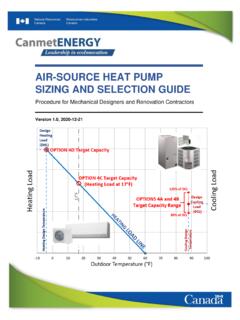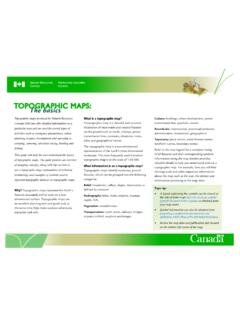Transcription of Guidelines for RTK/RTN GNSS Surveying in Canada
1 Guidelines for RTK/RTN GNSS. Surveying in Canada July 2015. Version Ministry of Transportation Minist re des Transports EARTH SCIENCES SECTOR. GENERAL INFORMATION PRODUCT 100-E. Main Authors: Brian Donahue, Jan Wentzel and Ron Berg Guidelines for RTK/RTN GNSS Surveying in Canada Surveyor General Branch 2013. Her Majesty the Queen in Right of Canada , 2013. Version July 2015 Page 1. Table of Contents Foreword .. 3. Table of Acronyms .. 4. 1. Introduction .. 5. 2. RTK/RTN Surveying Overview & Description .. 6. RTK vs. RTN .. 7. RTN Issues .. 7. RTK Issues .. 8. Site Conditions .. 8. Base Station Coordinates .. 9. 3. Project Planning .. 10. Theoretical Suitability .. 11. Practical Considerations .. 11. Area of project .. 11. Communication .. 12. RTN Base Stations .. 12. RTK Base Stations .. 13. RTK/RTN Rovers.
2 13. Project Configuration .. 13. 4. Survey Procedures .. 13. Equipment Calibration & Setup .. 14. Rover Receiver Settings .. 14. Rover Antenna .. 16. Rover Initialization & Survey Environment .. 17. RTK Initialization .. 17. Environmental Error Sources .. 18. Field Survey .. 19. Communications .. 19. Rover QC Indicators .. 19. Quality Control .. 20. RTK Base Station Quality Control .. 21. Post Processing .. 21. Horizontal Calibration .. 21. Vertical Calibration .. 22. 5. Summary and Conclusions .. 22. REFERENCES .. 24. Appendix A Summary of NAD83 (CSRS) in Canada .. 25. Appendix B Field Checklist .. 26. Appendix C Questions To Ask Your RTN Service Provider .. 28. Appendix D RTN Coverage in 29. Version July 2015 Page 2. Foreword This set of Guidelines for Real Time Kinematic (RTK)/Real Time Network (RTN) Global Navigation Satellite System (GNSS) Surveying has been prepared to assist the Surveying community in Canada through sharing what we view to be best practices.
3 The Guidelines have been prepared in response to needs expressed by the Federal, Provincial, and Territorial members of the Canadian Council on Geomatics (CCOG). The work was coordinated by the Canadian Geodetic Reference System Committee (CGRSC), a sub-committee of CCOG, and the Guidelines were developed by a team from different agencies, Federal and Provincial. A number of other individuals, agencies, and professional land Surveying associations in Canada have also contributed to this effort, and we wish to thank them for improving this product. Although the authors strove for accuracy, please let us know if you find any errors or omissions and we will amend the text accordingly in future versions. Special thanks to Brian Donahue, Geodetic Survey Division; Jan Wentzel, Surveyor General Branch; and Ron Berg, Ministry of Transportation Ontario; for their leadership in completing this project, and to all the CGRSC members who provided valuable feedback throughout the process.
4 We sincerely hope that these Guidelines make a positive contribution to Surveying in Canada . Version July 2015 Page 3. Table of Acronyms APC: Antenna Phase Center ARP: Antenna Reference Point CACS: Canadian Active Control System CBN: Canadian Base Network CSRS: Canadian Spatial Reference System CSRS-PPP: Online Precise Point Positioning (PPP) Service GDOP: Geometric Dilution of Precision GLONASS: Globalnaya Navigatsionnaya Sputnikovaya Sistema or Russian Global Navigation Satellite System GNSS: Global Navigation Satellite System GPS: Global Positioning System HI: Height of Instrument. In RTK this refers to the distance from the physical point to the Antenna Reference Point (ARP). HPN: Provincial High Precision Networks NAD83: North American Datum 1983. PDOP: Positional Dilution of Precision RINEX: The Receiver Independent Exchange Format RTK: Real-Time Kinematic RTN: Real-Time Network Version July 2015 Page 4.
5 1. Introduction Real-Time Kinematic (RTK) Surveying using Global Navigation Satellite Systems (GNSS). is now a common method used for both cadastral and engineering surveys in Canada . In recent years the number and extent of public and private Real-Time Networks (RTN). in Canada has been rapidly increasing. RTN surveys are becoming more popular where available, but RTK surveys are still the only option available in many parts of Canada . To see the current RTN coverage in Canada , refer to the coverage map in Appendix D. Both RTK and RTN GNSS surveys can achieve relative positioning with centimetre (cm). precision when following a set of best practices. There are several important factors that need to be accounted for when doing RTK/RTN surveys. Many of these are common to other types of GNSS surveys and include: equipment calibration, atmospheric errors, multipath, satellite geometry, reference system integration, redundancy, and validation.
6 There are also some recommendations in this document which are unique to RTK/RTN Surveying such as rover setup, communication problems, time windowing, and initialization. The goal of this document is to provide Professional Surveyors with a set of concise and easy to follow best practice Guidelines for achieving centimetre level RTK/RTN surveys. This document contains recommendations for all aspects of RTK/RTN Surveying , including a comparison of RTK and RTN methods. Additional recommended references and web links have also been included for users. This document serves as a reference, as well as a reminder of what is important. Appendix B includes a comprehensive field checklist that can be modified to an individual's specific requirements when doing RTK/RTN surveys, while Appendix C lists important questions that a RTN user should ask their provider as part of their project planning.
7 These Guidelines were developed by a working group which included: Brian Donahue from the Geodetic Survey Division (GSD) of Natural Resources Canada , Jan Wentzel from the Surveyor General Branch (SGB) of Natural Resources Canada , and Ron Berg from the Ministry of Transportation for the Province of Ontario (MTO). The recommendations in this document are based on a combination of author experiences, Guidelines from other agencies, and theoretical studies. Throughout this document the following terms are used: Users: Anyone performing either RTK or RTN surveys. GNSS: Global Navigation Satellite System and will be used to describe GPS, or GPS+GLONASS (as well as other systems ( Galileo) as they come online). Users should generally apply the same practices whether using GPS only or GNSS. The main advantage of GNSS is the increased number of satellites which may improve the geometry (especially when working in urban canyons or other partially blocked areas).
8 RTK: Single-base Real-Time Kinematic GNSS surveys. RTN: Real-Time Network GNSS surveys. Also used to describe the network of real- time base stations. RTN is also known as Network RTK (NRTK). Reference System: The term reference system is used in a general sense to describe a geographic coordinate system. Version July 2015 Page 5. Reference Frame: The term reference frame is used to describe a specific reference system. In Canada the official reference frame is NAD83 (CSRS). A. reference frame may also have different versions (or realizations) and epochs associated with it. For NAD83 (CSRS), the adopted versions (epochs) as of June 2015 are summarized in Appendix A. 2. RTK/RTN Surveying Overview & Description RTK Surveying is a relative positioning technique which measures the position of two GNSS antennas relative to each other in real-time.
9 One antenna is setup on a static point with fixed coordinates and is known as the base station. The RTK base station transmits its raw observations to the rover(s) in real-time and the rover uses both the rover and base observations to compute its position relative to the base (see figure 2-1). Figure 2-1 Typical RTK Setup. After a short initialization time (often less than a minute) the rover can continuously determine a precise 3D vector relative to the base station. This type of Surveying requires a reliable communications link between the base and rover as the rover needs continuous observations from the base. When working with short baselines (<10 - 20km), in open sky areas, and with good satellite geometry these relative 3D baselines can be determined to several cm (or better). RTK has proven to be a reliable and efficient means for determining precise relative baselines.
10 However, this method is limited to baselines of approximately 10 20km due to the effect that distance related errors (atmosphere and satellite orbits) have on the ambiguity resolution (initialization) and solution precision. The precision of RTK. decreases as the baseline length increases. Real-Time Network (RTN) Surveying has been developed to extend this base-to-rover range limitation. The RTN concept is that a group of reference or base stations collect GNSS observations and send them in real- time to a central processing system. The central processor then combines the observations from all (or a subset) of the reference stations and computes a network solution. From this network solution the observation errors and their corrections are computed and broadcast to rovers working within the bounds of the RTN.










